skip to main |
skip to sidebar
The Battlefield Line 'Santa Special' trains between Shackerstone and Shenton are of two types, which run alternately - the 'Classic' train with vestibule stock and the 'First Deluxe' train with corridor compartment stock. On the 'Classic' train, Santa's Helpers take groups of passengers, in turn, to see Santa Claus in his Grotto, where the children receive a Christmas present. On the 'First Deluxe' service, families or groups can book a private compartment with a Christmas Hamper of food, drink and Christmas Crackers and are visited by Santa distributing presents.
Events of Saturday 9th December 2017
"Well, that didn't go quite as planned" I commented to Carl just after 9.00 p.m. as I left the railway after a long day. I'd arrived at 6.30 a.m. to drive the Great Western 'Light Prairie' 5542 and Carl had arrived earlier to drive 'Cumbria', the second engine in steam that day. We'd both experienced various difficulties during our shifts but managed to operate the booked service and, hopefully, had helped to make quite a few adults and children happy.
Preparation
I'd last been on 5542 on 22nd October 2017 when we'd had an enjoyable and trouble-free day (although the exhaust did sound a little 'off-beat'). There's a bit about Preparation in my post describing that day On the Footplate. I'm forever banging on about the importance of careful preparation of steam locomotives by both the fireman and driver and it's a recurring theme in my posts labelled 'MIC' in tribute to the Mutual Improvement Classes of the old steam railways which continue, in one form or another, for today's preservation volunteers.
5542 was at the north end of the locomotive shed, over the inspection and disposal pit, with 'Cumbria' 'brewing up' behind her and the resident engine 'Sir Gomer' hidden at the back, out of steam. Tracy was the fireman (we don't indulge in the politically-correct term 'fireperson') and, having done the initial checks, she'd just lit-up but was unhappy with the fire. Apparently, there was general agreement that the particular batch of coal we were working through was dusty, smokey and reluctant to make steam. However, she was confident she'd sort it so I carried on with oiling-round the locomotive. Harry was our cleaner.
The water tanks on a side tank design prevent access from the side under the boiler except at the very front so oiling all the inside motion and axleboxes on the leading and driving axles means 'going underneath' the engine and climbing up. I discuss the various methods of carrying water on tank engines and the resulting problems of access to inside motion in the post Water, water, everywhere.
Unless you're very fit and flexible, 'going underneath' requires the engine to be over an inspection pit. Ideally, the pit should not be as I found it, with various piles of ash remaining from previous disposals and two inches of water at one end which the electric pump had failed to clear. However, I eventually completed 'oiling underneath' and clambered out of the pit.
The smoke from two engines meant that visibility in the shed was very poor and small flakes of coal were falling like snow. Eventually, with aggressive use of the blower, our boiler 'came round' but it certainly wasn't steaming as I'd expect from a Great Western engine. Right at the beginning of the twentieth century, the designer Churchward introduced a range of very carefully-proportioned taper boilers with Belpaire fireboxes. They weren't cheap to build but they gave excellent water circulation producing very free-steaming locomotives.
5524 on the 'Classic' train
The rather cramped track layout at Shackerstone requires careful choreography to manage two trains. We were to take the first departure of the day - the 10.00 a.m. 'Classic' so the Ground Frame was operated to let us come 'off shed'. The 5-coach 'First Deluxe' train was standing in platform 1 and our 5-coach 'Classic' train was in platform 2. The stock in platform 1 had been positioned carefully, just leaving room for us to clear the points so that the Ground Frame could be restored. The signalman, Leon, then 'gave us the road' to move through the crossover onto the running line. With the crossover restored, he then 'cleared' the disc ground signal to allow us onto our train.

Shackerstone track diagram. North is to the left on this sketch.
Click on diagram for uncropped view.
Once we were 'out of the way', Carl was able to bring 'Cumbria' off-shed. But he had a special task before we started the service. Our self-propelled tamper, which had been 'working in the section' earlier in the week, had decided to expire near 'Airport Bridge' (on the Shackerstone side of Market Bosworth) so 'Cumbria' was despatched to drag the failure back to Shackerstone.
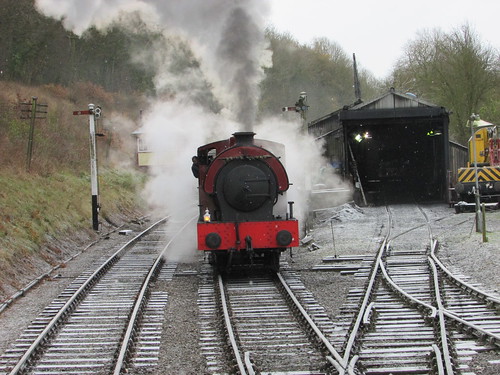
Battlefield Line 'Santa' trains 2017: Carl, driving 'Cumbria', arrives at Shackerstone having rescued the tamper.
Whilst 'Cumbria' was performing the rescue, we had coupled-up and started the steam supply for carriage warming. Our locomotive had a steam brake so, whilst light engine, it's conventional to leave the vacuum hose at one end of the locomotive 'off the stopper' so that the system operates as a 'straight steam' rather than a 'combination' (steam/vacuum) brake. Our Guard asked for vacuum but I noticed that our 'back bag' was still 'off the stopper' so I replaced this before placing the Driver's Combination Brake Application Valve in the 'create' position, so that the vacuum ejector would suck air from the train pipe and release the carriage brakes. Instead of the duplex brake gauge indicating the expected '25 inches' (partial vacuum is measured in 'inches of mercury'), it stubbornly stopped at just a few inches. Assuming that the fault was in the coaching stock, the Guard started to examine the coaches, noting a suggestion from Adrian that the exterior of the coaches had been washed during the week, so it was possible that a 'Butterfly Valve' had been disturbed. There's a brief description of 'Butterfly Valves' in the post MIC - The Working of Trains.
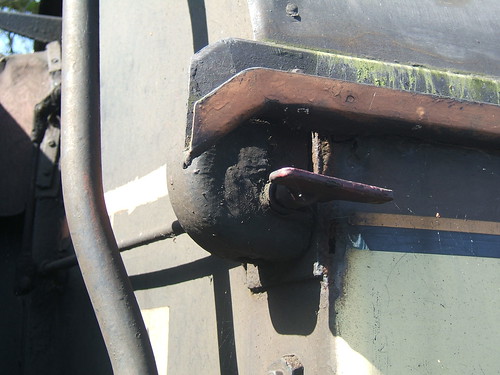
'Butterfly': The indicator for the communication cord on a passenger coach. With the 'flag' horizontal as shown the system is normal.
I didn't find out what our Guard discovered but, after a while, the vacuum came up to the required 25. The Guard should then do a 'Brake Continuity Test' by ensuring that taking the vacuum hose off the 'stopper' at the rear of the train destroyed the vacuum but, in practice, Guards often simply use the 'Setter' (the Guard's Brake Application Valve) in the Guard's compartment.
I'm afraid the Great Western, always prepared to be different, set their vacuum brake 'released' level at '25 inches' whereas every other British railway is content with '21 inches'. I think it was Churchward (before he succeeded William Dean as Chief Mechanical Engineer) working with Armstrong who made this decision. There's sound logic behind their thinking. 'Vacuum' brakes can be described as 'differential pressure' brakes. The bigger the differential between 'released' (a partial vacuum of 25 inches of mercury) and 'full application' (atmospheric pressure), the greater the brake force which can be produced by a brake cylinder of a given size. Looked at another way, more leakage can be tolerated in at system designed to run at '25 inches' before the braking effort available is seriously compromised. There's a little more on the topic in the post MIC - Brakes.
Ideally, the Guard or Driver would also carry out a functional brake test on the train. First, '25 inches' is created in the train pipe which should ensure that all train brakes are off. This vacuum is destroyed and the length of the train is inspected, ensuring that all brake blocks are 'on' (or, in practice, that all brake blocks on the non-platform side of the train are 'on'). If this is satisfactory, vacuum is re-created and the whole train is inspected again to ensure that all brake blocks are now 'off' and clear of the wheel tyres, with the exception of the Guard's coach, where the Guard's Handbrake will keep the brakes applied. The piston in each brake cylinder should be 'up' when the vacuum brake is applied and 'down' when the vacuum brake is released. Similarly, brake blocks should be tight against the wheel tyre when the brake is 'on' and hanging clear when the brake is 'off'. Where necessary, kicking a brake block will show whether it is 'on' or 'off'. I'm afraid I didn't carry out this test and I don't think the Guard did.
It's not unusual for Santa trains to be late away. All seats are normally pre-booked and, although the booking form clearly states "We are not able to hold departure of trains for late arrivals", the commercial department will often allow a few minutes 'grace'. When we finally received the 'Right Away' from the Guard, we made sure the handbrake was fully 'off' and I eased the regulator open. Steam poured from the open cylinder drain cocks but there was no movement. Vacuum was still correct, so I opened the regulator a little further. No movement. Sometimes, even with correct vacuum, some brake blocks on the train may be reluctant to drop clear of the wheel tyre. Rarely, the piston in the steam brake cylinder on the locomotive may 'stick' although, during preparation, cylinder oil is manually fed to the steam pipe leading to the brake cylinder from an oil pot in the cab to prevent this happening. Very rarely, the Guard may forget to release his handbrake (operated from a wheel in the Guard's Compartment). Finally, I opened the regulator even further and there was a small lurch from the engine. After a short pause, the whole train slowly moved. It was obvious that the exhaust beats from the chimney (four 'chuffs' for each revolution of the driving wheels) were uneven. With perfect steam distribution, they should all sound the same. No arrangement of Stephenson Link Motion gives perfect distribution, although Swindon's arrangement as used on the 'Light Prairie' comes close. But 5542 sounded distinctly unhappy.
As the train moved away, I 'linked up' the gear but left the cylinder drain cocks open a little longer because I'd seen that the boiler was rather over-full. The function of the cylinder drain cocks is to 'purge' the steam circuit and cylinders of condensed steam (water) which may collect whilst the engine is stationary. In a locomotive with slide valves, the 'buckle' which imparts the motion to the valve is arranged to allow the valve to move away from the port face which helps to clear any condensate. But the design of piston valves (as used on 5524) means that water can only escape through the drain cocks so 'aggressive' use of drain cocks becomes more important. Since water is incompressible, allowing a piston to squeeze water trapped in a cylinder risks serious damage, such as a broken cylinder cover or cylinder casting. Once I was happy that water had been expelled from the cylinders, I closed the drain cocks.
As we continued slowly up the cutting and passed under Barton Lane Bridge, things seemed a little better but I remained concerned at how 'off-beat' the exhaust sounded. We had been told to stop at Market Bosworth to pick up a staff volunteer. On receiving the 'Right Away' here, 5524 was once again rather reluctant to get under way but we carried on to Shenton and ran round our train. I discovered that the shunting signal controlled by the Guard from the ground frame reading from the run round loop to the single line had failed but the Guard displayed a green flag to authorise the movement. We coupled onto our train and created vacuum ready for the return journey, this time chimney leading. After a wait, the Guard whistled and displayed the green flag and we set off back to Shackerstone.
We arrived back late and were signalled into platform 2 at Shackerstone where I stopped with the leading coach just clear of the barrow crossing, meaning that our locomotive completely blocked the crossing. With the footbridge currently out of use, the barrow crossing is the only way for passengers to get to and from platform 1 so quite a crowd built up at the north end of the platforms waiting for us to uncouple and move forward into the North End sidings, where the bucket loading shovel was waiting to replenish our coal bunker.

Battlefield Line 'Santa' trains 2017: On our return to Shackerstone, we had to uncouple and draw away before passengers could use the barrow crossing.
With a full bunker, we moved back towards the station and stopped at the ground signal (lever 7: a Southern Railway pattern electrically-operated disc without the characteristic external floodlight). Ahead of us, our train was in platform 2 and the 'First Deluxe' train, with 'Cumbria' at the head, was still in platform 1. Once 'Cumbria had departed with the late-running 11.30 train, the ground signal cleared and we cautiously moved over the barrow crossing, ran through platform 1 negotiated the crossover outside the signal box. With the crossover replaced normal, the signalman cleared the "bottom dolly", allowing us to move onto our train and take water. We'd used about half a tank of water since leaving the shed that morning with a full tank. There was then nothing for us to do, except keep our train warmed, until 'Cumbria' returned with the 'First Deluxe' train, so I took a few pictures.
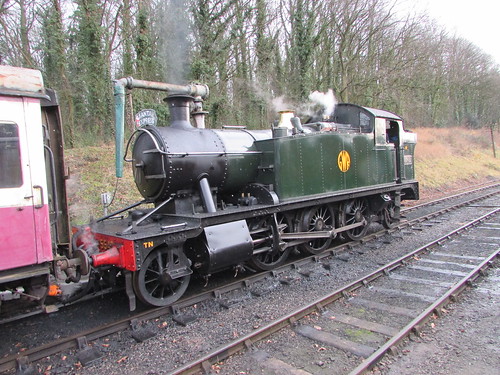
Battlefield Line 'Santa' trains 9-Dec-2017: Late-running 12 noon 'Classic' train ready to leave Shackerstone.
Santa Claus won't be hurried when he's distributing gifts on a train, so we were not surprised that 'Cumbria' returned having lost more time. We were keen to get started but, when we received the Green Flag and I opened the regulator, there was a loud, continuous 'blow' through the chimney but no movement. Having re-checked everything, I tried again, applying more power. The third attempt finally produced a sluggish movement and we slowly left the station, with a very uneven exhaust beat. We kept going but I couldn't be sure of the problem - possibly a broken piston valve ring.
Once again, we'd been asked to stop at Market Bosworth, this time so that train staff could establish how much more time Santa needed for his present distribution. On being given the 'right away' even full pilot valve regulator opening failed to produce movement as it should. The most likely reason was either a dragging brake or a damaged piston valve (or both). I put the reverser into 'Full Forward Gear' (we were bunker leading), opened the regulator and was rewarded by a few inches of movement. With the lever returned to 'Full Back Gear', this time we had movement in the intended direction and I was able to carry on to Shenton where, once again, we ran round our train. This time, we'd used half a tankful of water in just a one-way journey and Tracy was having to fire quite heavily to keep on top of things. I discussed our problem by mobile phone with Shackerstone and it was agreed that Adrian would take a look before we attempted our third and final booked trip that day.
 Tracy firing 5524.
Tracy firing 5524.
We returned to Shackerstone without incident but had managed to use most of our remaining water, suggesting that a fair amount of steam was going to waste. Shortly after our arrival, 'Cumbria' left with with the second 'First Deluxe' trip that day. With platform 1 now clear, we were able to shunt to the other end of our train and re-fill the water tanks. We were then asked to propel our 5-coach train to the North End No 2 siding where it would remain until the next morning. The line from the platforms to the North Sidings is on a down grade so, after a small push to start the train, it was a case of controlling the speed of the movement with the brake until our shunter, at the far end of the train, signalled us to stop.
When 'Cumbria' arrived back, Adrian appeared and, having made arrangements with the signalman and I'd collected the Single Line Staff, he took us on a test run part way down the line and back light engine. We agreed that, with 'Cumbria' still in steam, it might be prudent to dispose of 5524 and use 'Cumbria' on the last train, the 'Santa Evening Train Special'. Leon in the Signal Box loosed us onto platform 1, so that we could use the Ground Frame to reach the shed. Unfortunately, the train in platform 1 had stopped a little short and, even closed-up to the coaches, we were not clear of the Ground Frame points. 'Cumbria' was no longer attached to the stock so it fell to us to find a shunter, couple-up, create vacuum and, under the control of our shunter, ease the train forward sufficiently to clear the points. With the Guard's handbrake securing the coaches, we uncoupled and moved the engine to the shed. Having made sure that there was plenty of water in the boiler of 5524, Tracy, Harry and I made our way to the station. Carl had watered 'Cumbria' and coupled it to the stock in platform 1. Once I'd relieved him on 'Cumbria', Carl then finished disposal of 5524 for us.
'Cumbria' on the 'Santa Evening Train Special'
In the section 'Notes on driving Cumbria' in the 2016 post Sunday at Shackerstone there's some information about 'Cum
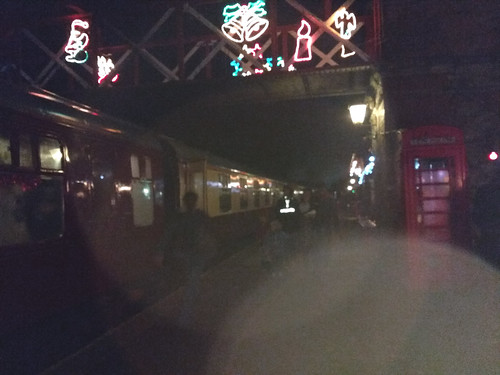
Battlefield Line: Christmas illuminations for the 'Santa' trains 2017.
Our last run was timed to start at 6.15 p.m. and, of course, it was dark (we were just 12 days before the Winter Solstice). The passengers managed to arrive on time and we were only a little late departing. Driving on a traditional British steam railway at night is quite different from driving on roads. There's no powerful headlight and sound cues become more important to the driver to identify his position. Increased light pollution today means that the sky is rarely completely black - nearer tall objects can appear as a dark silhouette against a dark purple horizon, provided that the driver can retain his night vision when, each time the fireman opens the firedoors to feed coal to the fire, there's an intense white or yellow glare from the firehole. There's a little about driving at night on the Battlefield Line in the section titled 'The Specials' in the post 'Operation: Market Bosworth' - On the Footplate. There's a little more in general about railways at night in the post here.
Because Santa was making his way through the train greeting all our visitors, our speed was modest and we were asked to stop at Market Bosworth (where there were more Christmas illuminations on the platform). We were soon on our way again to Shenton, where the series of traditional lamp standards along the platform cast a dim but welcome glow. I eased-up the locomotive to make uncoupling easier but failed to persuade the regulator to close properly. After we were 'un-hooked', I couldn't get the reverser into 'full back gear'- it remained 'steam locked' in mid-gear. This is an irritating habit 'Cumbria' (and other engines) sometimes display which I discussed in the section 'Steam Lock' of the 2017 post Bank Holiday with Steam and Diesel. A bit of brute force (and a lot of not-very-ladylike language) eventually released the lever and we ran round without further delay. We were told to return gently as Santa completed his task but without stopping at Market Bosworth. On the Shackerstone side of Market Bosworth, we received the 'tip' that we could resume normal line speed so, complying with the lower limits through Headley's Crossing and the approach to Shackerstone, we were able to finish up with a little 'romp'.
I was careful to stop correctly in platform 1 at Shackerstone to leave room for 5542 to come 'off-shed' the following morning and we uncoupled. Then we were asked to re-position the 'Classic' train from the North Sidings to platform 2, ready for the morning. I was told we'd a shunter and I asked if the "strings had been pulled". 5542 had put the set in the sidings "blowing 25 inches". Since 'Cumbria' "blows 21 inches" it was essential that all the release cords along the train were pulled before I attempted to Create vacuum. On receipt of the 'move away' hand signal, I attempted to move but 'Cumbria' was slipping badly. Well, the train was on a reverse curve, on a wet rail with an adverse gradient and we were making slow progress so, encouraged by voices from the ground, I persevered for a while but when we stopped again I asked for "better and further particulars" of the string-pulling. It appeared that, in the dark, there had been some confusion and either not all the strings had been 'pulled' or the residual vacuum had not been fully discharged. After more delay, we received the 'move away' hand signal again and, this time, we slowly dragged the 5-coach train into position in platform 2. We then lost no time in uncoupling and moving to shed where we levelled the fire and filled the boiler. I completed the paperwork, made the "Well, that didn't go quite as planned" comment to Carl and went home.
Related posts on this website
Shackerstone Santa Specials.
All my Battlefield Line posts.
On the Footplate.
All my MIC posts.
My photograph albums
Where necessary, clicking on an image above will display an 'uncropped' view or, alternately, pictures may be selected, viewed or downloaded, in various sizes, from the albums listed:-
5542.
Battlefield Line 'Santa' trains 2017.
All my Battlefield Line pictures.
When I was young, I found out about the private underground railway operated by the Post Office (as we then called it) to transfer mail between major sorting offices in London. I was fascinated by pictures of rather primitive-looking driverless narrow gauge electric trains.
Brief History
By 1911, worsening congestion on London's roads gave rise to the plan for an underground railway extending around 6.5 miles linking sorting offices at Paddington, Western District, West Central, Mount Pleasant (Clerkenwell), King Edward Building, Liverpool Street/Broad Street stations and Eastern District. A contract to build the railway was given to John Mowlem in 1915 but the shortage of materials and manpower caused suspension of the work in 1915 and the line was not completed until February 1927.
The line was 2-foot gauge, double-track, with reversing loops at both ends of the system and also at principal intermediate stations. In between stations, the two tracks were carried in a 9-foot diameter tunnel with sectional cast-iron lining at a depth of around 70 feet. At station approaches, 7-foot diameter single-line tunnels led to two parallel 25-foot diameter station tunnels at a shallower depth linked by cross-passages with lift access from the sorting office above. At either end of stations, gradients of 1 in 20 decelerated arriving trains and accelerated departing trains (this technique is also used on some of London Underground's lines). In general, each station tunnel accommodated a through line, a platform line and the platform itself, back-to-back with the other platform.
The very long platforms at Mount Pleasant were divided into three by two sets of scissors crossovers, allowing three trains in either direction to be simultaneously dealt with, independently arriving and departing using the through line.
The driverless trains were electric, powered from a central third rail at 440 volts d.c., reduced to 150 volts d.c. in stations (where the line speed limit of 40 m.p.h. was reduced to 7 m.p.h.).
At the west end of Mount Pleasant station, a double-track branch diverged and, climbing through a tunnel and turning through 180 degrees, terminated in the depot and workshop in a large basement area. For safety reasons, there was no third rail within the depot and trains were driven manually from a 'pulpit' via an overhead power system at 150 volts d.c.
In 1987, to celebrate 60 years operation, the railway was re-branded as 'Mail Rail' and the rolling stock was painted red but in 2003, the line was closed and 'mothballed'.
Rolling stock
The original electric rolling stock was 4-wheel long-wheelbase, resulting in excessive rail and flange wear. Between 1930 and 1936 an articulated design by 'Greenbat' (Greenwood and Batley) replaced the original rolling stock. The new locomotives were 4-wheel short wheelbase, with one axle driven and two small carrying wheels. A train comprised two of these locomotives joined back-to back by a chassis without wheels which carried the mail located on a pivot pin and load bearing plate on each locomotive.
An order for 34 replacement units with the same articulated layout was placed with 'Greenbat' in 1980 but, following that firm entering administration, the order was completed by Hunslet.
When the line was 'mothballed', the rolling stock comprised a mixture of 1930 and 1980 stock, with some later modifications.

Post Office Railway, Mount Pleasant showing 1930 rolling stock (Photo copyright: Marcel Gommers, via photo-forums.net).
Unofficial visitors
From time-to-time, the closed railway attracted the attentions of unofficial visitors or 'urban explorers' and there are various internet reports on these incursions, for instance, see Urban Ghosts or Beyond the Boundary.
A New Beginning
In 2013 the British Postal Museum announced plans to re-open part of the network as a tourist line and in September 2017 the Postal Museum opened in Phoenix Place with an optional out-and back ride on a section of Mail Rail.
Events of Thursday 30th November 2017
The Postal Museum
On 30th November 2017, I visited the Postal Museum and took the ride on Mail Rail. The main museum was busy, with plenty of adults and children enjoying the interactive exhibits outlining the history of the postal service, telegraphy and the public telephone service. There was a cafe, toilets and the inevitable souvenir shop. It was all well done and the staff were friendly and attentive so I enjoyed my brief visit although personally I prefer more old-fashioned interpretation.
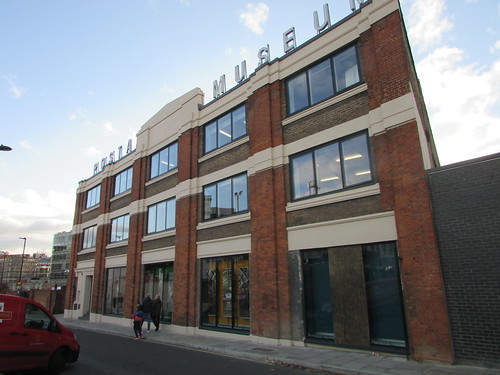
The Postal Museum, Phoenix Place, London:
The Mail Rail Tourist Train
To avoid the possibility of queuing, I'd made a fixed time internet pre-booking to travel on Mail Rail, which has a separate street-level entrance on the opposite side of Phoenix Place leading into another souvenir shop in part of the huge Mount Pleasant Sorting Office.
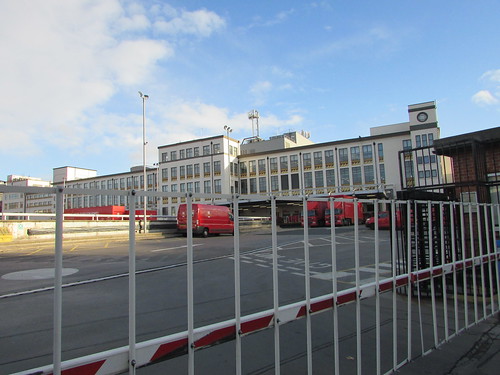
Mount Pleasant Sorting Office, London:
The new tourist railway starts and finishes in the former depot underneath Mount Pleasant Sorting Office, reached by either stairs or a lift from the souvenir shop at street level.
Most of the original trackwork in the depot area has been removed, leaving a waiting area and museum space but many of the original fittings like overhead crane rails and the depot power system have been retained. A new train boarding/alighting platform has been built at the head of the double-track branch which leads to the main railway.
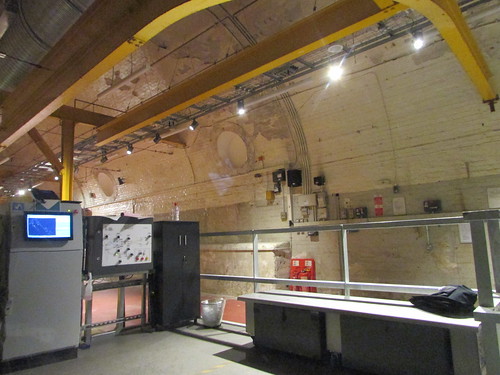
Postal Museum, Mail Rail: View from train boarding/alighting platform, showing control panels on the left and the brick-vaulted construction of the sub-surface former depot area.
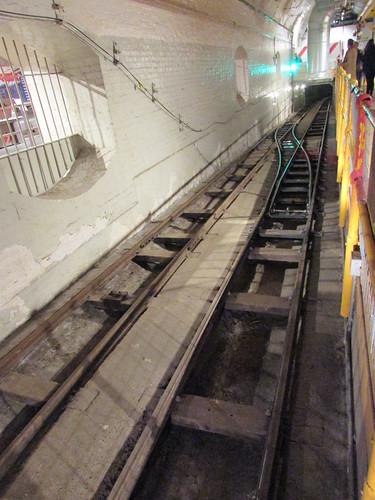
Postal Museum, London: View of double-track branch leaving the train boarding/alighting platform which leads to the main railway.
Two new battery-powered trains have been provided. At the time of my visit, only one was in use. There is a driving cab at each end. Passengers enter individual compartments through side doors and are enclosed by curved, transparent plastic hinging roof sections, creating an effect rather like being in a aircraft cockpit. We boarded the train and staff closed the doors and roofs. After a warning over the public address from the driver not to lean against the doors and roofs (which have interlocks to stop the train), we set off, descending the branch leading to the main line.

Postal Museum, London: View from the Mail Rail tourist train as it descends from the depot area to join the Eastbound main line.
We stopped in the Eastbound platform at Mount Pleasant and watched an audio visual presentation about the history of the line from the train. As the journey proceeded, we paused a couple more times for another audio visual presentation and a pre-recorded announcement about the layout of the line.
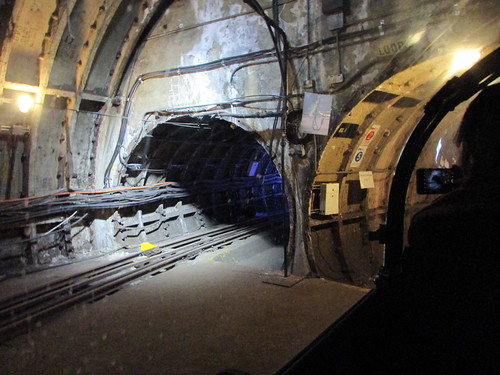
Postal Museum, London: View from Mail Rail tourist train leaving Mount Pleasant.
The train took the reversing loop at the east end of Mount Pleasant station, offereing a brief view of the low level 'graveyard' sidings where old rolling stock is still stored, rejoining the main line now travelling westbound. Having passed through the long, unused westbound platform, we diverged onto the depot branch and finished our journey at the train boarding/alighting platform we'd left about twenty minutes earlier.
The Mail Rail Museum
The remaining exhibits in the depot area illustrated the history of the Post office Railway and the Travelling Post Office service.
The idea of transferring post short distances by rail had been tried as early as 1863 and the Postal Museum has one of the original 4-wheeled vehicles on display. This pneumatic system operated between Euston Station and Eversholt Street 1863-1866 and again in 1873-1874. The vehicles were propelled through a shallow-buried tube by air pressure from a steam-driven fan.
When the Post Office Railway opened in 1927, it had a manually-driven battery electric locomotive for maintenance use. This is on display.

Postal Museum, London: 1927 battery-electric locomotive.
The picture below shows the iconic 1930 articulated train, comprising locomotives joined back-to back by a chassis without wheels which carried the mail.
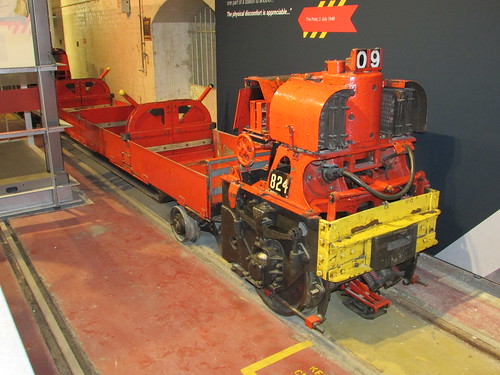
Postal Museum, London: 1930 articulated train.
At the rear of each locomotive, the chassis for mail was attached to a pivot pin with a load bearing plate.
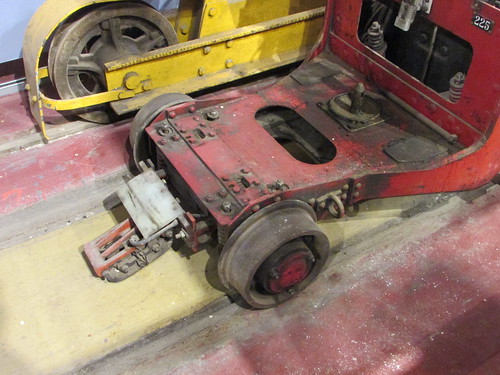
Postal Museum, London: 1930 locomotive, showing method of attaching the chassis carrying mail. Note the electric pick-up 'shoe'.

Postal Museum, London: The original appearance of the 1980 locomotives. Various modifications were applied to some units.
An impressive miniature slide signalling frame which controlled the elaborate layout at Mount Pleasant is on display.

Postal Museum, London: The impressive 55-miniature slide signalling frame which controlled Mount Pleasant.
There was also a mock-up of a section of a Travelling Post Office sorting van (complete with moving floor) with the opportunity to try your hand at sorting on the move and a display of mail exchange apparatus.
Even if you're not a dyed-in-the-wool railway enthusiast, there was plenty of interest at the Postal Museum.
Track diagram
There a track diagram showing the line at the time it was mothballed in 2003 in the 'Quail Track Diagrams':-
'Railway Track Diagrams Book 5: Southern and TfL' Third Edition, published by TRACKmaps (ISBN 978-0-9549866-4-3).
Related posts on other websites
Although the links worked at the time this post was published, changes made by that website's owner may 'break' the link.
The Postal Museum.
London Post Office Railway.
My photograph albums
Where necessary, clicking on an image above will display an 'uncropped' view or, alternately, pictures may be selected, viewed or downloaded, in various sizes, from the albums listed:-
Postal Museum, London.
At the time of writing, the United Kingdom has only one high speed railway, the Channel Tunnel Rail Link, CTRL or 'High Speed 1'. My firm, Ford Electronics, has had an involvement with two of the classes of passenger multiple units and one class of freight locomotive that work on the line (the original Class 373 operated by Eurostar, the Hitachi 'Javelin' Class 395 operated by South Eastern Trains and the Class 92 locomotive operated by various companies). Despite this association, I'd not managed to travel over the whole of CTRL until the trip described below.
The first section of CTRL (extending from Southfleet Junction to the Channel Tunnel) had opened in 2003 but trains to and from London had to use conventional lines to complete their journey. In 2006, I'd travelled over that first section of CTRL on a test train from Waterloo International to Paris (Nord), as described here.
In 2007 CTRL was completed between Southfleet Junction, Stratford International and St. Pancras International and Eurostar services transferred from the short-lived Waterloo International to St. Pancras International. At that time, Hitachi were building the Class 395 trainsets for use on CTRL and there's a short post Class 395 Trainsets. Late in 2007, I visited Ashford in connection with systems testing on the first of the Class 395 trainsets and that night-time visit is described here. Although we took the test train from Ashford to Dollands Moor to carry out tests, we used the conventional lines, not CTRL.
After the Class 395 went into service, it wasn't until February 2017 that I managed a trip from St. Pancras International to Ebbsfleet International and back - that's described in the post here.
So, having travelled on CTRL in 2007 from Southfleet Junction to the Channel Tunnel (and beyond) and in February 2017 from St. Pancras International to Ebbsfleet International, that left about 3km of CTRL (from Ebbsfleet International to Southfleet Junction) I'd not travelled on. I remedied that deficiency in November 2017, when I travelled from St. Pancras International to Ashford International and back as described below.
Journey on Thursday, 30th November 2017
I'd first seen the rebuilt St. Pancras International in 2008 and my generally favourable reaction is recorded in the post London's Terminal Stations. The South Eastern high speed services operated by Hitachi Class 395 electric multiple units use platforms 11, 12 and 13 on the east side of St. Pancras International. There's more information on the line from St. Pancras International to Ebbsfleet International in my earlier post here. Briefly, on leaving St. Pancras, CTRL curves right giving brief views of the North London Line and the East Coast Main Line before plunging into the twin bores of London Tunnel 1 (around 7.5 km long), emerging after a few minutes into the depressing grey concrete 'station box' of Stratford International where a number of passengers got off and boarded. We continued through the 10 km twin tubes of London Tunnel 2 at speed and reeled off another 13 km on the surface around Rainham before plunging under the Thames through the 3 km twin tube Thames Tunnel. Then, we were slowing for our stop at Ebbsfleet International.
Once we left Ebbsfleet International, I had about 3 km of 'previously unexplored route' before we came to Southfleet Junction (where my test train to Paris had joined CTRL in 2006) followed by Singlewell Maintenance Depot.
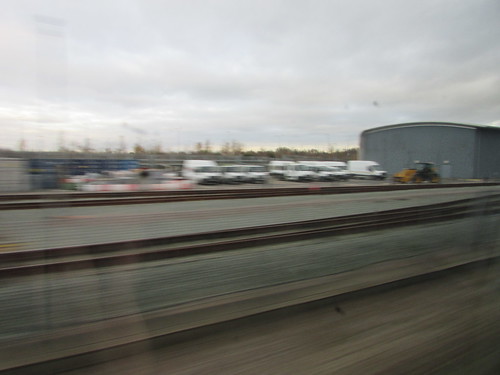
High Speed 1: Singlewell Maintenance Depot.
I'm afraid the combination of high speed and a very dull day made photography disappointing. I failed to capture perhaps the most interesting view, on the left of the train, as we crossed the River Medway where, looking downstream, the imposing bulk of Rochester Castle rose up on the right bank. Shortly after, we passed through North Downs Tunnel (just over 3 km long) and sped on towards Ashford. There were four short tunnels, the loops at Lenham and the 120m long Westwell Leacon Lane Tunnel. On our left, the third-rail electrified line from Maidstone ran parallel and I noted the Tarmac site at Hothfield with private sidings served by this line.
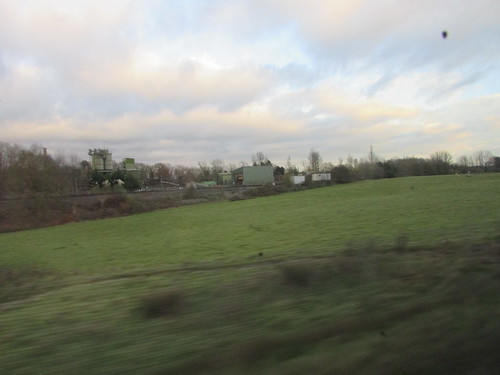
High Speed 1: Looking left from a Down train, the nearby conventional line from Maidstone East serves Tarmac's private sidings at Hothfield.
What is now called Ashford International station lies on the original South Eastern Railway (later the South Eastern and Chatham Railway) from London to Folkestone and Dover. To the west of the station, the line to Maidstone diverges northwards. To the east of the station, the line to Canterbury diverges northwards and the line to Hastings diverges southwards.
The new CTRL line by-passes Ashford International Station just to the north using the Ashford Viaduct. To cross both the Maidstone and Canterbury lines, CTRL passes under the Maidstone lines using Ashford Cut-and-cover Tunnel, then an incline connects to Ashford Viaduct which extends over the line to Canterbury.
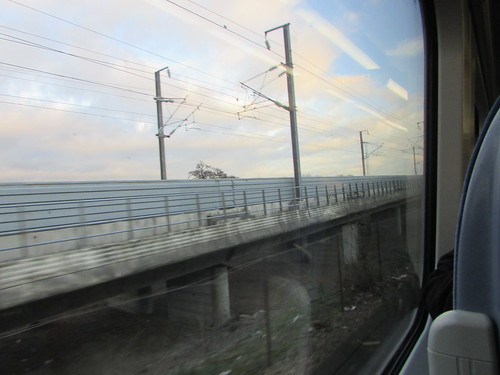
High Speed 1: View from Class 395 approaching Ashford International on the Down West Chord. Ashford Viaduct shown allows Channel Tunnel trains to bypass the station.
The rebuilt Ashford station derives its 'International' suffix from two new double-track chord lines - the West Chord leads from CTRL to the west end of Ashford International station, the East Chord leads from CTRL to the east end of Ashford International station.
My train from St. Pancras International used the Down West Chord to leave CTRL, pass under the Maidstone lines then cross over CTRL (still in the cut-and-cover tunnel) so as to enter platform 6 at Ashford International. Platforms 3,4,5 and 6 have both third rail 750 volt d.c. and overhead 25 kV a.c. electrification so my train arrived using overhead power and changed to third rail prior to leaving for Sandwich. South Eastern high speed trains towards London reverse this procedure, arriving using the third rail and changing to overhead in the platform, before joining CTRL using the Up West Chord. Flexibility is provided since Platforms 3,4,5 and 6 are signalled for movements in both directions.
Both the West Chord and East Chord lines are used by Eurostar trains calling at Ashford. International services can leave CTRL, stop at Ashford International and rejoin CTRL, remaining on 25 kV a.c. power throughout.
South Eastern High Speed trains (domestic) are confined to platforms 5 and 6 with platforms 3 and 4 reserved for Eurostar (international) services.
The weather was dull and cold and I had an appointment late afternoon so I only remained at Ashford long enough to take a few pictures of what remains of the older station. Then, I caught a South Eastern High Speed service from Platform 5 back to St. Pancras International.
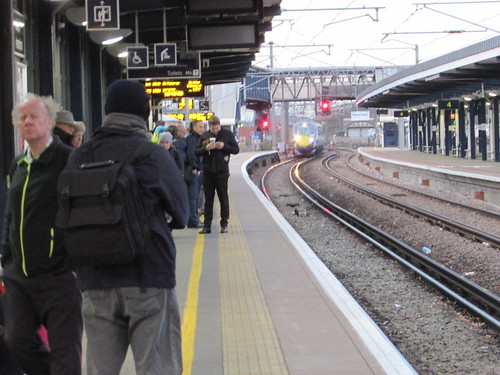
Ashford International: Class 395 approaching Platform 5 en route for St. Pancras International.
By Rail to the Continent
Early railways sought to promote cross-channel travel. Then (as now) new railways were authorised by an Act of Parliament. The South Eastern Railway (SER) obtained parliamentary approval for a line from London to Dover in 1836, but parliament mandated the sharing of existing lines at the London end, resulting in a roundabout route via Redhill. From Redhill, William Cubitt then provided the South Eastern Railway with an almost straight main line with reasonable gradients to Folkestone and Dover. Major intermediate stations (Redhill, Tonbridge, Paddock Wood, Headcorn, Ashford and Folkestone) were provided with through lines for fast trains and platform loops for stopping trains (Tonbridge, Ashford). Construction started in 1838 and the line was opened in 1843 to Folkestone, then Dover the following year.
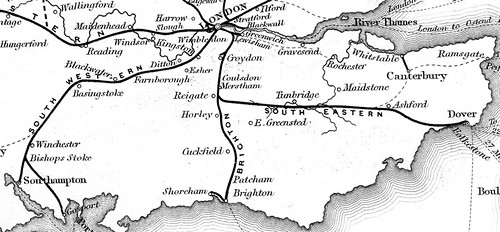
Railways in the South East of England in 1840 (from Whishaw).
The SER had a bad-tempered relationship with both its passengers and other railways, leading in 1853 to the East Kent Railway promoting a shorter line from London to Dover which would also serve important towns like Chatham and Rochester. The challenger railway had perpetual funding difficulties. It changed its name to the London Chatham and Dover Railway (LCDR) in 1859 and participated in the joint venture to build Victoria Station which opened in 1860. Somehow, both the SER and the LCDR struggled on until 1899 when they agreed to operate jointly as the South Eastern and Chatham Railway (SECR).
There's a little more about the SECR in the post Origins of the Southern Railway: Part 3 - S.E.C.R..
Ashford
As railways proliferated in the 19th century, Ashford became an important railway town. The SER built a new locomotive works at Ashford in 1847 which replaced the railway's original facility at New Cross. Following the joint operation agreement of 1899, work originally done at Longhedge by the LCDR was progressively transferred to Ashford. Following the Grouping in 1923, new building was concentrated at Eastleigh but Ashford locomotive works survived for repairs until 1962 and for wagon building until 1982. The picture below shows the extent of the works, situated to the east of the station on the south side of the main line to Dover, in 1929.
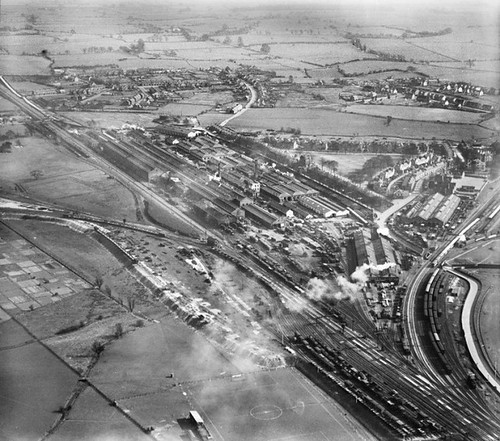
Ashford Railway Works 1929 (Photo: Kent History Forum).
Modern Railway Maps
Details of High Speed 1 and what remains of the S.E.C.R. today are shown in the 'Quail Track Diagrams':-
'Railway Track Diagrams Book 5: Southern and TfL' Third Edition, published by TRACKmaps (ISBN 978-0-9549866-4-3).
Related posts on other websites
Ashford Railway Works (Wikipedia).
Related posts on this website
Class 373 Test Train to Paris.
Class 395 Trainsets.
Testing Class 395 Trainsets.
Channel Tunnel Rail Link.
Origins of the Southern Railway: Part 3 - S.E.C.R.
My photograph albums
Where necessary, clicking on an image above will display an 'uncropped' view or, alternately, pictures may be selected, viewed or downloaded, in various sizes, from the albums listed:-
London: St. Pancras Station.
High Speed 1.
Ashford International.
The locomotive 'Ring Haw' first visited Peak Rail for the Santa Specials in 2016. There's a report on that visit here. 'Ring Haw' returned for the 2017 Christmas season and, on 2nd December 2017, I was the driver, with Phil as fireman, on the first day of the popular Santa Specials. For these services, the load had been increased to eight bogie coaches. Operation on the day was top-and-tailing with 'Penyghent' which was specially authorised, as in 2016, to give 'Ring Haw' assistance on certain sections of the route to comply with the owner's load limits.
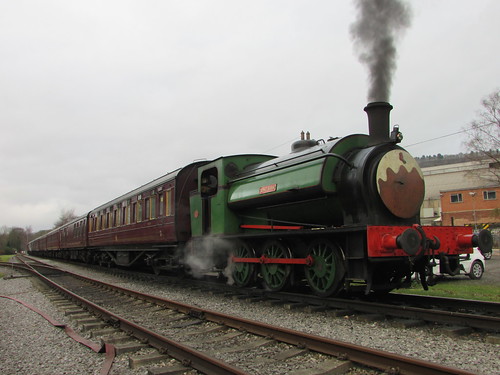
'Ring Haw' at Peak Rail, Christmas 2017.
Matlock Musical Theatre were on the platform at Rowsley to entertain everybody with carols and Christmas songs and entertainers travelled on the train. The highlight, of course, was Santa distributing presents to all the boys and girls on the train. Grown-ups received mulled wine and mince pies.
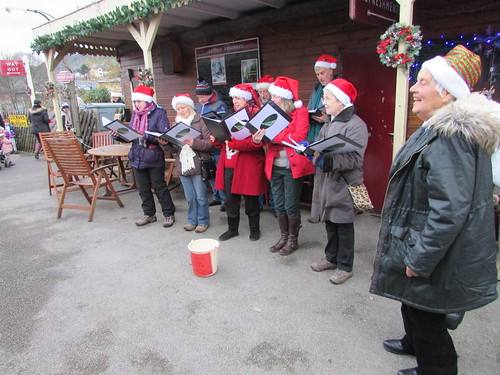
'Ring Haw' at Peak Rail, Christmas 2017: Matlock Musical Theatre were at Rowsley to entertain everybody with carols and Christmas songs.
As expected, 'Ring Haw' performed well and, despite steam heating the 8-coach train throughout the day, proved economical on coal and water.
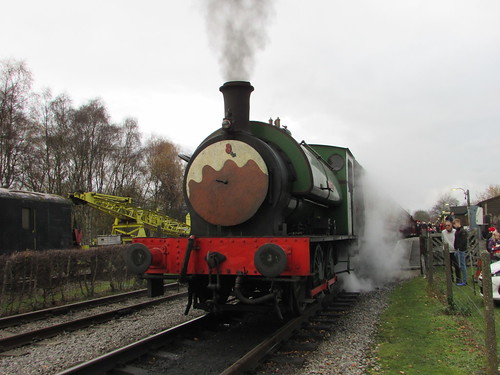
Peak Rail, Christmas 2017: 'Ring Haw' ready for the last departure of the day from Rowsley.
Related posts on other websites
Matlock Musical Theatre
Related posts on this website
Peak Rail Santa Specials ('Ring Haw' in 2016).
All my posts on Peak Rail.
All my posts on Santa Specials.
My photograph albums
Where necessary, clicking on an image above will display an 'uncropped' view or, alternately, pictures may be selected, viewed or downloaded, in various sizes, from the albums listed:-
'Ring Haw' at Peak Rail (2016 plus 2017).
Peak Rail 'Santa' trains, 2017.
All my Peak Rail pictures.
Before I left on my Myanmar trip at the end of September 2017 (that trip is described in a series of posts, the first of which is here), I'd offered some dates for the end of October and November to both the Battlefield Line and Peak Rail. I discovered that the Battlefield Line had covered all the October 'turns' and was not running steam in November in preparation for the intensive 'Santa Special' season in December. Peak Rail rostered me for the 11th November after which they, too, had a short break to get ready for the 'Santa Specials'.
The Battlefield Line: 22nd October 2017
Although I'd not been rostered on the Battlefield Line during October, on Friday 20th October, I received an urgent text telling me that Shackerstone had 'lost' the crew for both Saturday 21st and Sunday 22nd October. I offered to do either day and was asked to cover Sunday which (like Saturday) had a 'Gold' Footplate Experience prior to the public service. There's a description of the format of the 'Gold' Footplate Experience in an earlier post here (when we were using 'Austerity' tank locomotive 'Cumbria'). Jamie had offered to fire on the Sunday so I knew we'd have an enjoyable day. Our engine was Great Western 'Light Prairie' 5542.
It had been some years since I'd driven 'Light Prairie' 5542 - there's a very short post here.
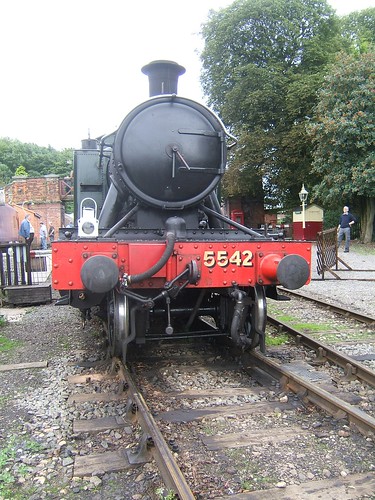
5542 running round its train at Shackerstone during the visit in 2010.
5542 Layout of Valve Gear
All the 2-cylinder Great Western designs (until Hawksworth produced his remarkable Pannier tanks with Walschaert's motion for shifting empty stock in and out of Paddington) featured Stephenson Link motion with four eccentrics mounted on the driving axle between the frames to provide the necessary valve events. Where outside cylinders and valves were required, the movement of the dieblocks was transmitted from inside the frames to outside via the intermediate valve rods, rocking shafts and finally via the valve rods to the valve spindles, as shown in the diagram below.
 Click here for a larger view.
Click here for a larger view.
The diagram above is drawn as for a larger, tender engine. In the 'Light Prairie', the intermediate valve rods are shorter and set at a steeper angle so as to connect to the inner valve arm attached to the rocking shaft mounted on the framing. The outer valve arm then drives the valve rod connected to the valve spindle.

5542: Link motion for right-hand cylinder.
The set of pictures of 5542 here has a number of pictures of the valve gear illustrating how the layout in the diagram above is implemented in practice.
5542 Sight Feed Lubricator
The sight feed lubricator is mounted in the cab on the boiler backhead, in front of the driver. Moving parts in contact with superheated steam (such as the valves, pistons and regulator valve) require lubrication with a special, compound mineral oil, formulated to retain its properties at high temperature. Sight feed (or hydrostatic) lubricators are often used for this purpose and Swindon developed a range of suitable lubricators. Through training and the issue of circulars, Swindon ensured that drivers understood the method of operation and the importance of the Sight Feed Lubricator. A copy of Great Western Circular 5801 issued in November 1937 by C.B. Collett can be accessed (and downloaded) here.

5542: Boiler backhead.
5542 preparation
Whilst Jamie raised steam, I set about reminding myself of all the oiling points as I carried out the daily examination and oiling. The most obvious change since 2010 was that the 'shaded' tankside lettering 'G W R' had been changed for the GWR Roundel which was used between 1934 and 1942 (see 'GWR Roundel' link below). There were changes to the mechanical arrangements for remote control of the regulator used when working 'push-pull' or 'Auto' trains. I discovered that the locomotive had acquired a Stone's electric generator since I last saw her - certainly not a Swindon feature - but not yet in use. I talk about electric generators on steam locomotives in the post Electrical Systems on Steam Locomotives. And the locomotive certainly has a hopper ashpan now.
Having started with oiling the 'easy bits' accessible from ground level alongside the engine (principally crankpins, big ends, little ends and crossheads), I moved into the pit underneath the locomotive and clambered up, perching on a mixture of brake rigging and axles, as I dealt with the Stephenson link motion and axleboxes. Then it was onto the framing at the front of the engine to deal with the vacuum pump oil pot, rocking shafts and a few more oiling points. In the cab, I topped-up the two oil boxes which serve the trailing coupled wheels.
We were kept pretty busy all day, so I didn't manage to take any pictures, but I've included pictures from an earlier visit by the locomotive in 2010.
Peak Rail: 11th November 2017

Locomotive 'Jennifer' at Matlock Town earlier in 2017.
I discovered that this was to be the final weekend for 'Jennifer' at Peak Rail. Although the locomotive engineering department had failed to cure the oscillation in the drawgear which had created some problems for passengers (and crews), she was a 'solid steamer' and strong so I viewed her return to Llangollen with some regret. She was facing 'downhill' so we operated the service coupled to the south end of the train, 'top and tailed' with the diesel electric.
Operating on a Saturday, we saw East Midlands Trains Diesel multiple units at Matlock Town two or three times in the day.
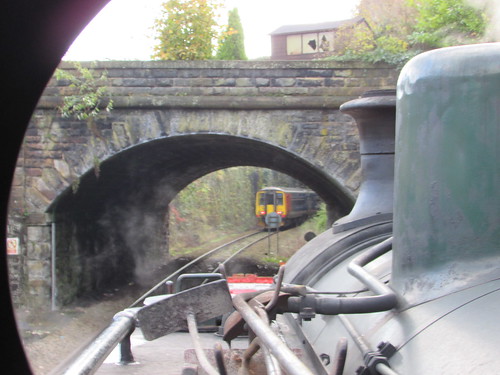
Peak Rail 11th November 2017: View from the footplate of 'Jennifer' on arrival at Matlock Town as an East Midland Trains Class 156 departs.
Related posts on other websites
Although the links below worked at the time this post was published, be warned that changes by a website's owner may 'break' the links.
GWR Roundel.
Locomotive 5542 Limited.
Related posts on this website
All my Battlefield Line posts.
All my MIC posts.
All my Peak Rail posts.
My photograph albums
Where necessary, clicking on an image above will display an 'uncropped' view or, alternately, pictures may be selected, viewed or downloaded, in various sizes, from the albums listed:-
5542 at Shackerstone.
All my Battlefield Line pictures.
'Jennifer'.
Peak Rail 2017.
All my Peak pictures.
Events of Wednesday, 18th October 2017
My trip to Myanmar had been a remarkable odyssey. I'd met so many kind people, seen so many sights, both familiar and new, that I could hardly believe the experiences I'd had. Finally, I faced the journey returning to England and, even with a ticket for Emirates Business class, the prospect was a little daunting. Emirates had changed their schedules since my previous visit to Myanmar so the first leg of the flight, from Yangon's modernised Mingalardon airport, left at 02:10 hours, early in the morning. I was able to use my comfortable room at the Belmond Governor's Residence until 11.30 p.m. when the hotel provided their car (an Executive model 'Alphard' in black) to take me to the airport. At that time of night, we made good time to the airport and the spacious facilities in Terminal 1, only open a few months, were quiet so check-in and security were swiftly completed. There was an extensive new lounge shared by a number of airlines I'd not visited before. I enjoyed a thick pea soup as I'd not had much to eat since breakfast but I didn't take any pictures of the new lounge.
We boarded the aircraft, a Boeing 777-200, on time, and I was settled in an unusually-empty Business Class cabin by the friendly cabin crew. I couldn't remember flying on a 777-200 before and I found the seating arrangements in the row I'd been given a little odd compared with the Boeing 777-300ER that I'm more familiar with.

Up, Up and Away: Boeing 777-200 Yangon to Dubai.
During the flight to Dubai, I watched a little 'Doctor Who', slept and then watched more 'Doctor Who' until we neared Dubai.
Our arrival at Dubai was scheduled for 5.55 hours local time, but, with my body still on 'Yangon Time', it felt much later to me. That, together with the enforced activity of leaving the aircraft and having to negotiate the transfer through the airport to my connecting flight meant that I didn't expect to sleep again. A number of my more recent flights into or out of Dubai have involved transfer buses to sometimes remote areas of the huge airport. But this arrival was at Terminal C and we disembarked through an airbridge into the not-yet-completed building. A reasonably long walk aided by some moving walkways took me to a transfer area where, having passed through security, I was able to discover from the passenger information screens the gate from which my connecting flight would leave, requiring another long walk, again with some assistance from moving walkways. As I plodded through the huge terminal, I realised that the departure gate was actually very close to the arrival gate, but one floor down.

Dubai Airport: Walking to the departure gate for Birmingham at incomplete terminal C. The 'palm trees' are fully electrified with uplighters.
There was a very smart Emirates lounge near the gate. Rather than unpack my laptop, I attempted to log-on to one of a series of 'Lenovo' desk computers provided for travellers. I was either very tired or very unlucky because it was not until I tried the third computer that I succeeded in connecting to my e-mail.
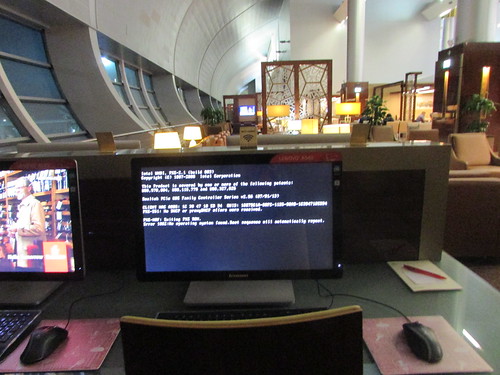
Dubai Airport: IT problems in the Business Lounge - "No operating system found".
I then typed part of a draft blog post before moving to the departure gate and boarding my connecting flight. This time, the aircraft was the familiar Boeing 777-300ER.
It took our aircraft a while, with various stops, to negotiate the taxiways to reach the departure runway. Looking back, I could see the usual row of Emirates wide-bodied aircraft lined up at the terminal we'd left.
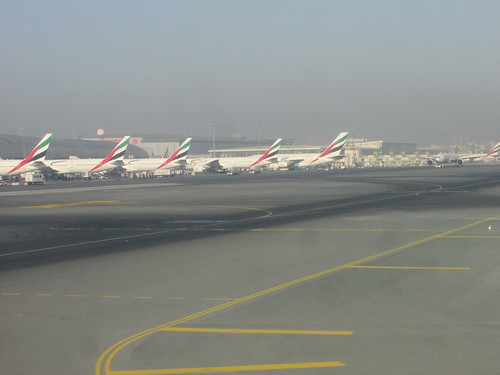
Dubai Airport: Looking back to the terminal we've left, showing Emirates 'wide-bodies'.
On the flight to Birmingham, sleep eluded me but I was fairly comfortable as I monitored our journey across the Middle East and Europe, taking occasional pictures of the changing scene.

From Dubai to Birmingham: Germany from five miles above.
The winds had been in our favour and we arrived at a rain-swept Birmingham about 20 minutes early. I had to wait a few minutes for my transport home, but I was quite content just to be safely back. It's nice to go travelling, but it was good to be home.

Birmingham Airport (BHX) in the rain.
Related posts on this website
This is one of a series of posts describing my 12th visit to Myanmar. The post Starting out is the first post in the series.
This is the last report on the trip.
Alternately, clicking on the 'All my Burma-2017(2) reports' link displays all the posts on this trip in reverse date-of-posting order.
All my Burma-2017(2) reports.
My photograph albums
Where necessary, clicking on an image above will display an 'uncropped' view or, alternately, pictures may be selected, viewed or downloaded, in various sizes, from the albums listed:-
Yangon Airport.
Up, Up and Away.
Dubai Airport, U.A.E.
From Dubai to Birmingham.
Birmingham Airport, England.
Events of Tuesday, 17th October 2017
I slept well again on Monday night and took a fairly early breakfast. I had two ideas in mind for my final day. The first was book purchases, the second rail travel.
Book buying
During previous visits, I'd learnt that the TAB Book Centre in the Taw Win Shopping Centre carried a good range of books in English about Myanmar, particularly reprints of recollections by English people who'd spent time in the territory. I'd already assembled a small collection (there's a bibliography in the post Kipling's Burma) and my aim was to extend this collection.
The Taw Win Centre is a shopping mall and hotel complex just 700 metres from the Belmond Governor's Residence so, breakfast completed, I set out on foot. The Taw Win Centre is bounded by Pyay Road, a minor road and the railway line at Pyay Road Station, so the floor plan is a right-angled triangle which invariably confuses me as I work through the various floors looking for the TAB Book Centre which is located on the third floor. The well-stocked bookshop also sells computer equipment.
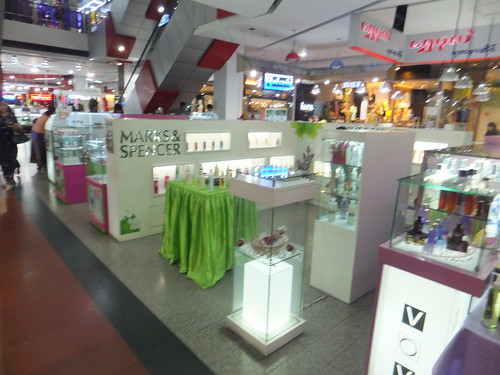
Yangon: Taw Win Shopping Mall in 2012.
An English-speaking assistant directed me to the section of books in English. I'd remembered that the store carried a wide range of Buddhist books so it seemed appropriate that the shop's sound system was playing a recording of a monk intoning a sacred text. However, after about five minutes, in a rather jarring change, the monk was replaced by a modern 'pop' song. I'd taken the precaution of taking a list of books already in my collection, in the hope of avoiding duplication but there were still plenty of interesting-looking titles to choose from. Having completed my selection, I completed my purchases in cash. Whilst credit cards are now far more widely accepted in Myanmar than a few years ago, the TAB Book Centre remains a cash establishment. I walked back to the hotel, warm but delighted with my new books.
Rail travel
A new port, operated by Hutchison Ports, has been established at Thilawa, a little downstream from Yangon city and the old docks. 'Yangon' is now a cruise destination but the cruise ships invariably actually dock at Thilawa. I'd seen the new port from afar when I visited Kyaik Khauk Pagoda in 2016 (see the post Visiting Pagodas. Elaborate enquiries had suggested that there was just one train each day from Yangon Central Station to Thilawa, leaving at 12:15 in the afternoon and not returning until the evening. Each time I'd considered attempting this journey, something had intervened to prevent me. So, with an unexpected surge of confidence, having succeeded in my book purchases, I took a cab to Yangon Central Station and made my way to the suburban booking office on platform 6/7 where they speak some English.

Thilawa Port viewed from Kyaik Khauk Pagoda.
In the hope of avoiding confusion, I'd written the destination, time and ticket price (in 'Roman' characters) on a piece of paper. The ticket clerk confirmed that my information was correct, and immediately issued me with a ticket (but written in Myanmar characters). With suburban trains coming and going regularly, identifying the correct departure remained a problem but the ticket clerk assured me that he would alert me to the right train. A few minutes later, the clerk re-appeared and directed me to a Diesel Multiple Unit standing in the Western part of the platform. Since my destination was east, I queried this. "Thilawa, Thilawa" he re-assured me. Well, I knew that some eastbound trains started from the western end of the platform so I felt I had no alternative but to board the indicated train. Almost immediately, an inspection of tickets took place. The ticket inspector studied my ticket very carefully but was satisfied so I once again enquired whether the train was for Thilawa. He was emphatic that it was, just before the train set off westwards on a long clockwise circuit of the Circle line which didn't take me to Thilawa.
I still don't know what went wrong with my careful arrangements except that travelling on the Circle Line is something of a 'Rite of Passage' for many foreign tourists, so perhaps they just thought 'Foreign Tourist - Put her on the next Circle Line Train'. I never tire of watching the passing scene on the Circle Line so, lacking the energy to bound off the train and plan another adventure, I meekly accepted my fate and travelled around most of the Circle Line. A further discouragement was that it was raining quite heavily as we left Yangon Central, although it dried-up later in the journey.

The Circle Line (Yangon - Mahlwagon c/w): Leaving Yangon in heavy rain.
Signalling on the Circle Line
Yangon's Circle Line is described in the post here. It is double track throughout, signalled by a variety of 2-aspect and 3-aspect colour light signals from a number of signal cabins with intermediate sections controlled by Automatic Block.
Yangon Central Station is still controlled by an elderly British-made Westinghouse Style 'L' miniature lever frame, described here.
Kyee Myin Daing remains a delight for me with two mechanical signal boxes (North and South), facing points provided with Facing Point Locks/Locking Bars and semaphore signals on the sidings. There's a description here and a report on an official visit here.
Insein has a Korean 'NX' (eNtrance-eXit) signalling panel also described here.
Da Nyn Gone has a locally-built signalling panel controlled by miniature switches, described here.
Mingalardon has another locally-built signalling panel controlled by miniature pushbuttons, mentioned in my report on an official visit here.
Paywet Seik Kone also has a locally-built push-button signalling panel, mentioned in my report on an official visit here.
My very first trip on the Circle Line in 2008 piqued my interest in the railways between Mahlwagon and Pazundaung. At Mahlwagon, the double track Circle Line joins the double track main line from Mandalay and there is quadruple track from there to Pazundaung, as shown in the diagram below. At Mahlwagon, a double junction gives access to the large Mahlwagon Marshalling Yard (an official visit is described here). At Pazundaung, two lines emerge from the Marshalling Yard and tangle with the other lines at the complex ‘flat crossing’ junction where trains to and from the Circle Lines cross the Up and Down Bago and Mandalay main lines as they pass from or to the local lines. This is because, at Yangon Central, long distance trains use platforms 1, 2, and 3 on the north side of the station whilst local trains usually use platforms 4, 5, 6 and 7 on the south side. There's the further complication, west of Pazundaung, of the splitting of the Down and Up Goods Lines (which by-pass Yangon Central Station to the south) and the junction to the single line branch to the old docks along Strand Road.

Myanma Railways: Simplified line diagram Pazundaung to Mahlwagon
Click for larger version
At the time of my official visit in 2017 mentioned above, I thought it likely that Pazundaung and Mahlwagon had similar locally-built installations but this is not correct. My German friend Dieter later wrote that Siemens modernised these areas in the 1960s as part of the Circle Line colour-light project. Certainly, when I checked my photographic record, I confirmed that, in the Mahlwagon and Pazundaung area, electric point machines and colour light signal heads are Siemens built. There is some ambiguity over the signal numbers originally carried on the posts (There appeared to be two signals 'M25'!) but the prefixes used 'M' and 'P' suggested two control panels. A further oddity is that three colour light signals at Mahlwagon carry line-of-white-lights route indicators although there are currently no track connections between the Circle Lines and the Bago lines.
Time for gaining a better understanding of the present arrangements is getting shorter because, as I mentioned in my post here, the Japan International Cooperation Agency is involved in modernising Myanma Railways and I saw new location cases and point machines in the Pazundaung area.
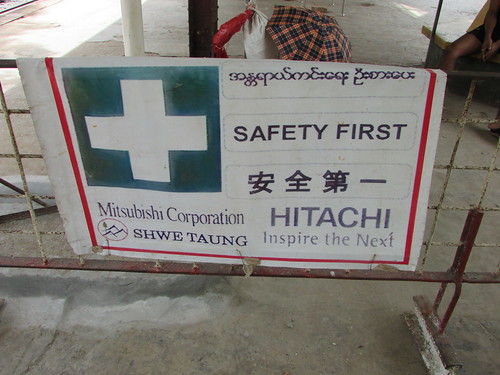
The Japanese railway modernisation project is well in evidence around Yangon.
Mahlwagon
It took my Circle Line train about two and a half hours to reach Mahlwagon, on the interesting four-track section described above. I decided to leave the train and explore the area around the station on foot, taking a number of pictures before returning to the station to catch the next service back to Yangon Central.

Mahlwagon Main Line seen from the north end of the Up Yard showing Train Number 5 Up (the 15:00 hours Yangon-Mandalay, due to arrive 05:00 the following day) with a Chinese-built Bo-Bo-Bo on a rake of Chinese-built 'air-bag suspension' coaches.
By this time, I was rather tired so, after a short period watching movements around the station, I made my way outside to find a taxi. I'd had an enjoyable and informative afternoon, even if it wasn't as planned. I was able to use my comfortable room at the Belmond Governor's Residence until 11.30 p.m., when the hotel car was transferring me to Mingalardon Airport. I spent the evening packing, drinking tea and trying to relax before my long night flight home.
Related posts on this website
This is one of a series of posts describing my 12th visit to Myanmar. The post Starting out is the first post in the series.
Clicking on the 'Next report' link displays the post describing the next events. In this way, you may read about the trip in sequence.
Next report.
Alternately, clicking on the 'All my Burma-2017(2) reports' link displays all the posts on this trip in reverse date-of-posting order.
All my Burma-2017(2) reports.
My photograph albums
Where necessary, clicking on an image above will display an 'uncropped' view or, alternately, pictures may be selected, viewed or downloaded, in various sizes, from the albums listed:-
The Governor's Residence Hotel, Yangon.
The Circle Line (Yangon - Mahlwagon c/w).
The Circle Line (Mahlwagon - Yangon Central Station c/w).
Getting there
On Thursday 16th November 2017, I attended the Rail Research UK Association (RRUKA) Annual Conference in London. After transfer to Wolverhampton station by car, I caught the 06:04 Virgin service to Euston. At that time of the morning, there wasn't much to see on the way down but I'm happy to report the train arrived on time.
I'd decided to walk to the venue at Kings Place (gritting my teeth that the location chooses not to use an apostrophe in spelling its name). I walked east along Euston Road, past St. Pancras to King's Cross station.
King's Cross Station
Having a little time in hand, I briefly examined the new and old concourses at the station, which sometimes uses an apostrophe in the name, sometimes not. I tend to be similarly inconsistent (depending how 'modernist' I'm feeling). I'm not a fan of the new concourse with its 'alien beanstalk' roof framing dominating the space.

King's Cross Station: The 'New' concourse illuminated.
But I've always had a soft spot for Cubitt's compact train shed at this terminus, unobtrusively but effectively carrying out its function.
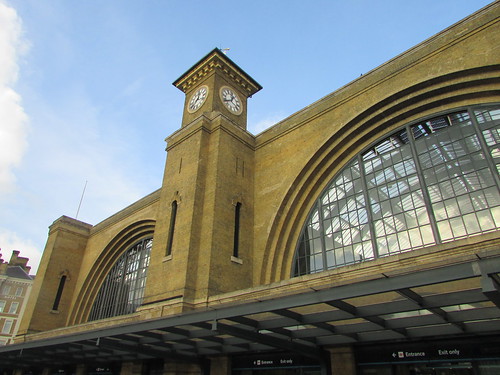
King's Cross Station: The simple but elegant end of the train shed is revealed.
Although I'm sure my long-suffering mother took me to look at King's Cross when I was a child, it was probably not until around 1974 that I became a regular visitor when my firm, Ford Electronics, supplied and installed an Electrification Telephone System for 100 route-kilometres of electrified railway on the Great Northern Line (briefly described here). My most unusual journey from King's Cross came in 2005 when, in connection with TPWS development, I travelled on a Class 373 Test Train from King's Cross to Grantham, described here. Somewhat later, Ford Electronics also modernised an aging British Rail-designed Tunnel Telephone system serving the Northern City line to Moorgate. Since the Moorgate line was actually controlled from King's Cross Power Box, special interface equipment was installed, and I became quite familiar with the Power Box over the years.

King's Cross Power Box: General view of operating floor in 2002.
'Related posts' below leads you to earlier mentions of King's Cross in this blog.
After my brief tour, I turned the south-east corner of the station building into York Way and, for the first time, noticed some modern steel bracing which had been added to Lewis Cubitt's venerable wall. One of the braces was in front of a Boundary Stone set in the brickwork and appeared to have cracked the face of the stone but I still found it a fascinating relic.

King's Cross Station: Insensitive bracing added to the SE corner of Cubitt's station building has virtually destroyed this boundary stone.
Origins of RRUKA
In 1993 state-owned British Rail was privatised with control of the infrastructure (and responsibility for safety and standards) passing to privatised Railtrack. Railtrack collapsed in 2001, resulting in the creation of a new body in 2003, the Rail Safety and Standards Board (RSSB) as an independent not-for-profit company limited by guarantee. Since then, a host of initiatives have been created (leading to an 'alphabet soup' of acronyms such as SPARK, CIRAS, SMIS+ and RRUKA). The Rail Research UK Association (RRUKA) was established in 2010 with core funding provided by RSSB, to form a partnership between the British rail industry and UK universities. Each year, there is a conference, currently held at Kings Place, London.
The venue
Kings Place is a modern building on the opposite side of York Way from King's Cross Power Box, mentioned above, just a few yards further north. The website here invites visitors to "Come and experience two world-class concert halls, purpose-built art galleries, a bar/café, waterside restaurant and award winning conference and events facilities - all under one roof." Although I tend to dislike modern architecture, Kings Place is thoughtfully laid out and appears to carry out its remit well. All the arrangements worked well throughout the day and I ended up fairly impressed.
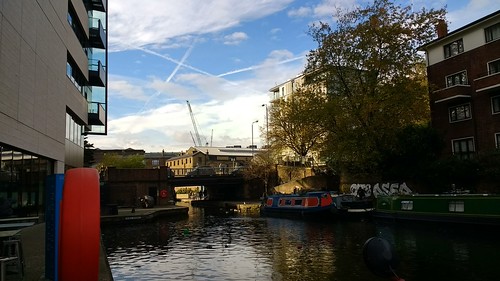
London: The Regent's Canal at Kings Place, looking towards York Way and Maiden Lane Bridge.
The event
Registration was quickly completed in the Music Foyer on the Lower Ground Floor where numerous polite and friendly staff were on hand to dispense beverages.

RRUKA Annual Conference 2017, Kings Place, London: Registration and beverages.
On time, delegates moved to the adjacent Hall 2 for the event itself. Hall 2 was equipped with effective audio-visual facilities (incorporating a Yamaha digital live-sound mixing console M7CL), theatre-style lighting and reasonably comfortable individual chairs.

RRUKA Annual Conference 2017, Kings Place, London: Hall 2 showing lighting arrangements and computer projector.
After opening remarks by Luisa Moisio (R&D Programme Director RSSB), the Keynote Address was given by Marco Caposciutto (Technical Director Trenitalia) and Ernesto Sicilia (Chairman /M.D. Trenitalia). This was followed by a review of research partnerships by Luisa Moisio and Sharon Odetunde (Head of Academic Partnerships RSSB). Next, there were two research presentations on 'Time spent by passengers at stations' and 'Benefits of mechatronically-guided vehicles on railway track switches', terminating in a short question-and-answer session.

RRUKA Annual Conference 2017, Kings Place, London: One of the Question and Answer sessions.
There was then an opportunity to visit the 'Blue-Sky Village' exhibition in the Battlebridge Room, where refreshments were served.

RRUKA Annual Conference 2017, Kings Place, London: The 'Blue-Sky Village'.
The morning session continued in Hall 2 with three research presentations covering automated servicing of passenger train fluids, a cab front cleaning robot and robotic systems for wheelset reworking, followed by questions and answers. The morning session concluded with three 'elevator pitches' for future studies.
A buffet lunch (with a choice of three 'mains') was served in the Battlebridge Room, giving ample opportunity to talk to the exhibitors in the 'Blue-Sky Village'.
At 2.00 p.m., the afternoon session was introduced by Stuart Hillmansen, Senior Lecturer at the University of Birmingham. Three more 'elevator pitches' were followed by two research case studies on the SmartDrive Project and the integration of real-time performance measurement with simulation. The afternoon coffee break offered a final opportunity to study the displays in the 'Blue-Sky Village'.
Iain Roche (Head of Innovation HS2) then gave the afternoon Keynote Address. The formal business of the day concluded with the presentation of the RRUKA Best Young Researcher Award and closing remarks by Stuart Hillmansen, after which delegates were invited to a drinks reception in the Music Foyer.
An interesting event, well-organised by RSSB and RRUKA.
Related posts on this website
Electrification Telephone Systems for British Rail.
London's Terminal Stations.
Redevelopment at King's Cross Station.
Class 373 Test Train to Grantham.
My photograph albums
Where necessary, clicking on an image above will display an 'uncropped' view or, alternately, pictures may be selected, viewed or downloaded, in various sizes, from the albums listed:-
London: King's Cross Station.
Kings Cross Power Box.
RRUKA Annual Conference 2017.





 Tracy firing 5524.
Tracy firing 5524.

















































